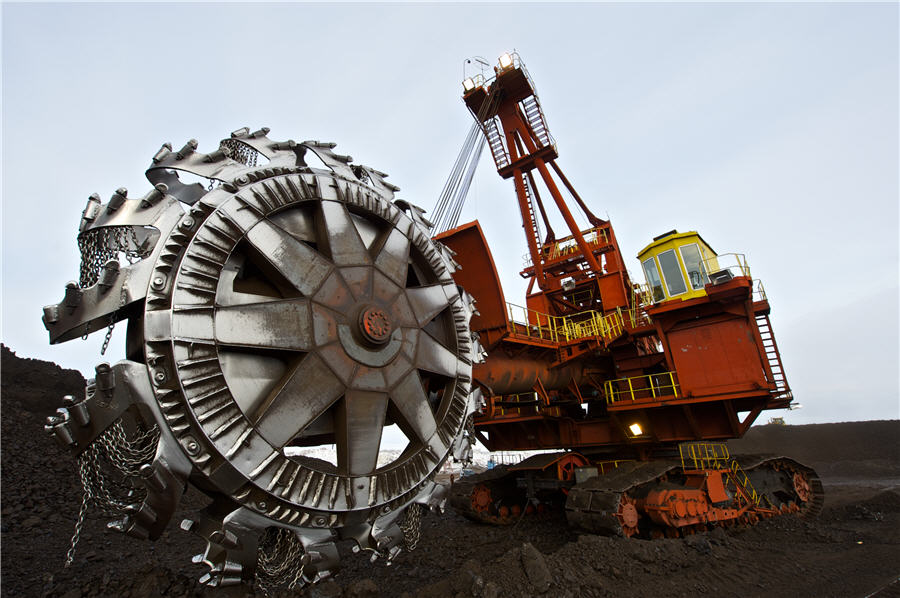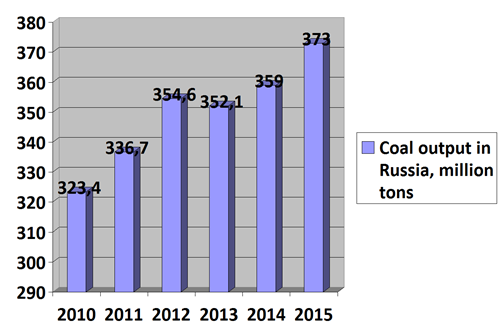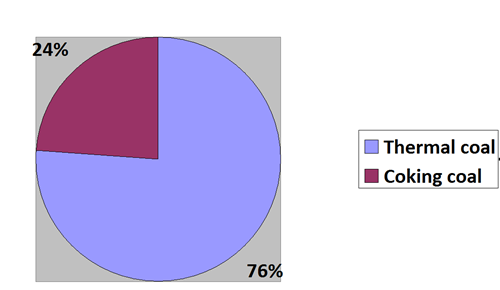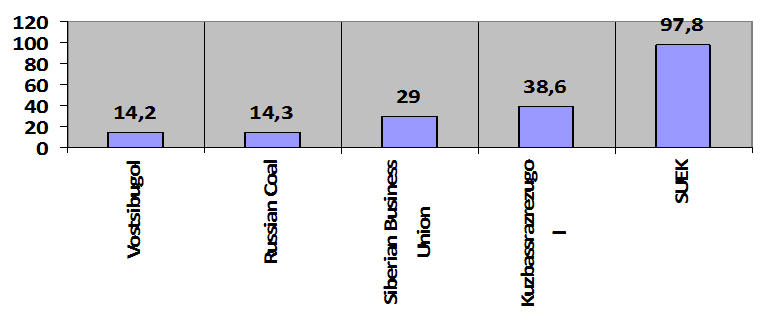
It is an open secret that the global electric power industry of which the coal industry forms a part is experiencing a system-wide reduction in both volumes and prices of energy resources.
In Russia, the coal industry now employs around 151,000 citizens, and another 500,000 people work in related industries, and the consequences of that trend have to be thought about at both corporate and national levels.
It is not surprising at all because coal companies are major enterprises for 31 Russian industry-based towns that have the total population of 1.5 million people.
Russia ranks sixth in the world when it comes to the total coal output. The privatization of coal industry completed following the end of the Soviet era resulted in coal being mainly mined in Russia by privately owned joint stock companies.

Bilan Uzhakhov – Russian Coal Group Director General
In Q1 2016, coal in Russia was mined by 169 companies, 107 of which dealt with open-pit mining and 62 took coal in mines. The industrial reserves of operating Russian companies that mine power station coal stand at about 15 billion tons. Nowadays it is only Russian Coal Group that has the reserves of 1.2 billion tons of thermal coal.
In Q1 of this year, the total output made 96 million tons, which is 6% more than in the similar period of last year. It is thermal coal that occupies a substantial share in the total output. Coal deliveries increased by 4% compared to the similar period of last year.
On the face of it, the state of the Russian coal mining industry does not seem to be beyond hope. However with that said the Russian coal industry has to face lots of problems and risks both in the domestic market and those pertaining to export.
Domestic consumption: gas and Kazakh import as major threats
The ‘low water’ in the hydrosystems of Siberia and the Far East contributed to success within the Russian national coal industry in 2015, with the load transferred from hydropower plants to steam plants, including coal-steam plants. But it is hardly probable that we will have much luck this year.

The programmes of gasification are being fullfilled in Siberia according to plans. Low prices of natural gas will facilitate the development of those programmes.
Import of cheap coal from Kazakhstan poses another problem for coalers. Thus in Q1 2016, as many as 5.3 million tons of power station coal was brought from that country, which is 10% of the total domestic Russian consumption. However, extremely low global prices still make the domestic market attractive in terms of the selling of thermal coal. The competition will get even stronger there.
Russian Railways’s rates now pose a significant problem for the domestic market. The result is that logistical costs are often used to cover all potential profits, and the conveying of coal to some potential clients makes no business sense. In fact, it is railway rates that are of crucial importance in today’s domestic sales market of Russian coal.
Export: devaluation is just respite but not a panacea
Coal ranks fifth in the list of basic export products in Russia. There was a continuous growth of Russian coal exports beginning from the post-Soviet times when there was an upward trend in global prices of coal. In terms of coal exports, Russia ranks third in the world after Indonesia and Australia. In Q1 2016, of all the volume of exports, 37.5 million tons was exported, which is 5% above the level of the relevant period of 2015. With that said the share of exports in the volume of Russian coal deliveries in Q1 2016 stood at 44.3%. In 2015, the coal export proceeds made USD 9.5 billion, and in Q1 2016 they made USD 1.9 billion.
90% of exports accrue to thermal coal. Today, Russian coal is exported to 50 countries, including Japan, Cyprus, the UK, China, the Republic of Korea, Finland, Poland, and the Baltics. The main focus of attention was an upward trend in deliveries of coal through eastern ports in Q1 2016 (+18% compared to the same period of last year).

In 2015, Poland, South Korea, Japan, China, Bulgaria and the Baltics became the main export areas for Russian Coal Group. Our export can be divided into Europe (51% of exports) and the Asia Pacific Region (49%). We carry out deliveries to China (that is among our top priority export areas) through traders and through overland borders directly. Poland is treated by Russian Coal Group as another top priority foreign sales market where we can witness a reduction in the output by local enterprises due to loss-making production companies, and our products are highly competitive.
Last year’s weakening of the rouble revived the Russian coal export and served as a commercial driver for business. The devaluation of the rouble gave support to export and gave Russian coal the edge in the world market. But it should be mentioned that such trend cannot last for long. No devaluation has ever resulted in any long-term positive effect.
Investment as a source of survival but not development
A decrease in the volume of investment (that is not expected to exceed RUB 52 billion) has posed a threat to the Russian coal industry. Considering the current rate of exchange, it is less than USD 1 billion. For comparison: in 2013, investment in Russian coal industry made about USD 2 billion. The effects of the decrease in investments will have to be felt not only in 2016 but also throughout the years 2017-2018 since the coal industry is rather passive in itself. The inertia principle is now applicable to the investment reserve created in 2013-2014.
Now it is clear that the investment generation by Russian coal companies will tend to the minimum survival estimate. I suppose that further decrease in the volume of investment is out of the question because such decrease will surely endanger the existence of the industry. Absence of investment in production will result in an increase of production costs. The profitability reported by coal producers is weak as it is, and its figures can be even worse if no investment is made.
In 2015, investments by Russian Coal Group made about RUB 1.5 billion. Considering that our company occupies around 8% of the Russian market of thermal coal, it is quite good. In 2016, depending on the market conditions, we plan to invest another RUB 1.5 billion. Such volume of investment allows maintaining the existing company’s facilities that include 7 coal mines in the Amur region, the Republic of Khakassia and the Krasnoyarsk Territory where over 4,000 working people are employed.
Efficiency and cost effectiveness to be on the list of top priority tasks
Expenses incurred by Russian coal producers are ever increasing. Taking into account the devaluation, companies will have to pay a much higher price to upgrade the equipment, 60% of which comprises the imported equipment.
At such hard times the current market conditions must contribute to improving performance and efficiency of manufacturing processes at Russian coal companies. Most efficient production management has become the formula for survival for Russian coal companies. However, management must not dwell on only traditional manufacturing processes. We should adopt and adapt the best management practices used by companies that operate in highly competitive industries. Flexibility, a rational approach to the solution to problems and enhanced responsibility for the efficiency of the capital used are still on the list of management priority tasks.
The companies that are afraid of getting rid of non-performing assets with high costs of production and that refrain from making solid investments in the modernization of production are doomed to closure.
5 of Russia’s largest companies that mine thermal coal
(Thermal coal output in 2015, million tons)

Continuous optimization of costs is also of crucial importance. Today’s market conditions make coalers go on an economy drive, which is unusual for many Russian companies.
Today, most of the Russian coal producers are losing money. Over the past few years, the companies’ expenses have increased dramatically, with export prices now recorded at the same level as in the years 2003-2004.
Should the dollar exchange rate be less than the current exchange rate, all the positive effect benefited from the devaluation will be lost. It will adversely affect the business efficiency of Russian coal producers. It is clear that it will result in many Russian coal mining companies being on the brink of bankruptcy. It is management expertise and skills that will show whether or not bankruptcy can be avoided.